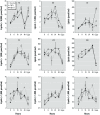Obesogens beyond Vertebrates: Lipid Perturbation by Tributyltin in the Crustacean Daphnia magna
- PMID: 25802986
- PMCID: PMC4529017
- DOI: 10.1289/ehp.1409163
Obesogens beyond Vertebrates: Lipid Perturbation by Tributyltin in the Crustacean Daphnia magna
Abstract
Background: The analysis of obesogenic effects in invertebrates is limited by our poor knowledge of the regulatory pathways of lipid metabolism. Recent data from the crustacean Daphnia magna points to three signaling hormonal pathways related to the molting and reproductive cycles [retinoic X receptor (RXR), juvenile hormone (JH), and ecdysone] as putative targets for exogenous obesogens.
Objective: The present study addresses the disruptive effects of the model obesogen tributyltin (TBT) on the lipid homeostasis in Daphnia during the molting and reproductive cycle, its genetic control, and health consequences of its disruption.
Methods: D. magna individuals were exposed to low and high levels of TBT. Reproductive effects were assessed by Life History analysis methods. Quantitative and qualitative changes in lipid droplets during molting and the reproductive cycle were studied using Nile red staining. Lipid composition and dynamics were analyzed by ultra-performance liquid chromatography coupled to a time-of-flight mass spectrometer. Relative abundances of mRNA from different genes related to RXR, ecdysone, and JH signaling pathways were studied by qRT-PCR.
Results and conclusions: TBT disrupted the dynamics of neutral lipids, impairing the transfer of triacylglycerols to eggs and hence promoting their accumulation in adult individuals. TBT's disruptive effects translated into a lower fitness for offspring and adults. Co-regulation of gene transcripts suggests that TBT activates the ecdysone, JH, and RXR receptor signaling pathways, presumably through the already proposed interaction with RXR. These findings indicate the presence of obesogenic effects in a nonvertebrate species.
Conflict of interest statement
The authors declare they have no actual or potential competing financial interests.
Figures



Comment in
-
A Closer Look at Obesogens: Lipid Homeostasis Disruption in Daphnia.Environ Health Perspect. 2015 Aug;123(8):A219. doi: 10.1289/ehp.123-A219. Environ Health Perspect. 2015. PMID: 26230663 Free PMC article. No abstract available.
References
-
- Barata C, Baird DJ. Phenotypic plasticity and constancy of life history traits in laboratory clones of Daphnia magna Straus: effects of neonatal length. Funct Ecol. 1998;12:412–419.
-
- Barata C, Baird DJ, Soares AMVM. Phenotypic plasticity in Daphnia magna Straus: variable maturation instar as an adaptive response to predation pressure. Oecologia. 2001;129:220–227. - PubMed
-
- Barata C, Lekumberri I, Vila-Escalé M, Prat N, Porte C. Trace metal concentration, antioxidant enzyme activities and susceptibility to oxidative stress in the tricoptera larvae Hydropsyche exocellata from the Llobregat river basin (NE Spain). Aquat Toxicol. 2005;74:3–19. - PubMed
-
- Campos B, Garcia-Reyero N, Rivetti C, Escalon L, Habib T, Tauler R, et al. Identification of metabolic pathways in Daphnia magna explaining hormetic effects of selective serotonin reuptake inhibitors and 4-nonylphenol using transcriptomic and phenotypic responses. Environ Sci Technol. 2013;47:9434–9443. - PubMed
Publication types
MeSH terms
Substances
LinkOut - more resources
Full Text Sources
Other Literature Sources

